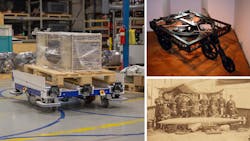Where are Automated Guided Vehicles Going, and How Will They Get There?
Automated guided vehicles (AGVs) are a hot topic in industry. Yet, the seeds of today's advances were planted a century ago. But what were the technologies that have led to modern AGVs, and where do we go from here?
AGVs’ lineage as self-propelled vehicles can be traced back to DaVinci's plans for a self-propelled cart he made in the 16th Century and the Whitehead self-propelled torpedo from the late 19th Century. But it wasn’t until after the 1930s that the three technologies critical for self-propelled vehicles and today’s AGVs were developed:
1. The prototype electromechanical autopilot developed by Sperry in 1933 depended on gyroscopes to ensure an accurate heading. While today we use a miniaturized version of Sperry’s development, the lineage is clear.
2. The plan to land a vehicle on the moon in 1961 encountered problems with the 2.5-sec. delay for the vehicle to receive commands sent from earth. To solve that problem, NASA developed the world’s first self-driving vehicle. It had cameras mounted to it and carried a computer programmed to analyze the cameras images and then follow a solid white line on the ground.
Some AGVs in industrial use today use similar technology to follow magnetic tape embedded in the ground or mirrors aligning a route, while others rely on laser guidance and retroreflectors to calculate their positions.
Current 2D and 3D mapping systems use cameras, LIDAR and ultrasound to train AGV vehicles to establish routes for subsequent use in a warehouse or factory.
3. In 1987, German engineer Ernst Dickmanns developed “dynamic vision” for vehicles. It used banks of cameras and microprocessors mounted on a vehicle to detect objects in the road, filtering out the inevitable noise to identify only objects deemed important.
An advanced version of this technology is still used today in AGVs, adding stereo cameras for depth perception or time-of-flight technology to measure the transit time of reflected light.
High-resolution CMOS sensors have been developed to emulate an eagle’s eye. Directly imprinted on the chip are micro-objective lenses of different focal lengths and fields of vision, allowing a computer-generated field of view with the widest possible viewing range.
These three developments are key components of AGVs in use today, yet to supercharge AGV development we needed the development of critical enabling technologies.
Industry 4.0 revolutionized business, driving efficiency and productivity through machine-to-machine communications and automation using the Industrial Internet of Things (IIoT). The synergy of big data and artificial intelligence, cloud computing and augmented reality leveraged diverse applications and technologies into previously unimaginable potential. Manufacturers and logistics providers were early adopters, introducing comprehensive materials handling and transportation systems.
However, businesses today find themselves at an inflection point in AGV evolution. Existing connectivity solutions constrain the advantages of newer technologies. So, while business owners prepare to digitize their businesses, those pursuing modern AGV technology are reluctant to install what may become restricting legacy hardware.
Business WLAN (Wi-Fi) and private 4G/LTE networks are currently used in manufacturing for remote machine and robotic control, process monitoring, predictive maintenance and current-generation AGVs. Wi-Fi supports AGVs with direct vehicle-to-vehicle (V2V) and vehicle-to-infrastructure (V2I) communication, while 4G/LTE systems support additional vehicle-to-network (V2N) connectivity. Yet, both systems come with peer communication limitations.
While mature, Wi-Fi is constrained by limited connectivity, having low range and reliability with high latency. It is also compatible only with other Wi-Fi devices and networks.
4G/LTE, while less mature, improves connectivity, range and reliability but retains an unacceptably high latency. It is also only backward-compatible with 2G and 3G hardware.
Both Wi-Fi and 4G/LTE are inherently unsuited for emerging AGV technologies.
V2X, the next big step, refers to vehicle-to-everything technology, which unlocks the power of AGVs and driverless cars. It includes enhanced augmented reality, cooperative driving, extended electronic (NLOS) vision and more precise positioning. V2X will be a game-changer for communication standards.
But V2X requires massive connectivity capacity. For example, it will need latency times of less than a millisecond for real-time applications and mobile broadband of more than one gigabit per second to support augmented reality. The connectivity must also be ultra-reliable.
5G technology offers a way to meet V2X demands. It will support the huge connectivity requirements and offer good range, high reliability and the low latency needed for real-time applications. 5G is also backwards-compatible with Wi-Fi and 2G, 3G and 4G networks.
5G technologies promise the next major changes in V2X connectivity and communication, smashing the current bottleneck stifling the evolution of automotive digitization and autonomous vehicles.
Yet, there is some work to be done. Industry legislation and global frequency allocation need to catch up with technological advances. Similarly, there are questions about security and privacy. Given that 5G promises to unlock the path from partial automation to full automation, where all driving modes are managed without human oversight, the question of failure tolerance is also critical.
While the term “exponential” is often hyperbole when used to describe change, there is no other adjective to better convey the huge acceleration of enabling technology in the last 10 years since the formalization of Industry 4.0. With 5G no longer a nascent technology, expect AGV development to advance quickly to full automation. And for those manufacturers considering AGV introduction, here’s a tip: 5G appears to be the future.
Luke Goodwin is content marketing manager for FlexQube.


